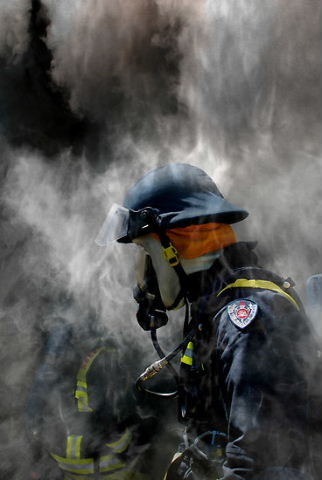Editor’s Note 8/3/2015: Welcome to another summer of record-breaking heat in the Northwest. From rain forests to wheat farms, thousands of acres have been burned. The Lake Chelan wildfire in Washington quadrupled in size; there have been 1,390 wildfires in BC this season; and more than 800 people are working to contain the Southern Oregon wildfires. Here’s a popular Flashcard from last summer with a few quick and easy ways to talk about how climate change is fueling these monster wildfires.
This week, the LA Times reported on the wildfire raging in Washington State, describing “tornadoes of fire” engulfing a small town. It’s a scary picture and a bleak reminder that global warming is amplifying certain kinds of destruction here, now, right in our backyard:
The Carlton Complex fire will probably go down as the biggest conflagration in Washington state history, torching about 240,000 acres and counting. Pateros, one of Washington’s littlest towns, was no match for its fury. An estimated 20% of the buildings in the city, population 600 or so, have been destroyed. There is no electricity, no drinking water.
Speaking about the fire, President Obama said, “A lot of it has to do with drought, a lot of it has to do with changing precipitation patterns and a lot of that has to do with climate change.”
Climate change is making for wildfires in the American West that are more severe and more difficult to fight. Some are calling the new climate-fueled wildfires “monster” or “mega” fires. It’s important to put wildfires into context the way Obama has. So, we’re reissuing our talking points on global warming and wildfires.
Journalists, policymakers, and advocates should reinforce the connections between climate change and the trend toward more frequent, wilder, hotter, bigger and less predictable wildfires. There are plenty of excellent resources to go deep on the science. (Some of the best are here, here, here, here, and here.) But mostly people need to hear the basics: Climate change is fueling dangerous mega fires.
Take last year’s Yosemite Rim Fire. After visiting the site, National Park Service Director Jon Jarvis said climate change is leaving the West more vulnerable to catastrophic wildfires that are huge, “incredibly difficult to control and very expensive.” “This is a gnarly fire,” he said. “It’s got high attention, huge fuels, big flame lengths and lots of really, really dry, climate-driven conditions.” Andrew Freedman lays out just how drought amplifies a wildfire like that one.
As fire geographer Michael Medler testified in a congressional hearing, “On the fire lines it is clear, global warming is changing fire behavior, creating longer fire seasons and causing more frequent, large-scale, high-severity wildfires.” (That was back in 2007.) The science here is clear. Low snow pack and early snow-melt along with hotter temperatures and more severe droughts are making forests dry and highly flammable. More and more people live next door to these tinderboxes. Fire season now lasts two months longer and destroys twice as much land as it did 40 years ago, according to Thomas Tidwell, the head of the United States Forest Service. Western fires are straining firefighting budgets to the max.
Climate change isn’t the only culprit creating the conditions for more severe and dangerous fires, but it doesn’t take a climate scientist or even a great detective to see the fingerprints of human-caused climate change on most wildfire crime scenes.
And this is just the beginning. In coming years, things are projected to get much worse. (For one example, according to Harvard researchers, by 2050—when my daughter is around my age—the area burned in the month of August could increase by 65 percent in the Pacific Northwest, and could nearly double in the Eastern Rocky Mountains/Great Plains regions and quadruple in the Rocky Mountains Forest region.)
Here are some simple, powerful ways to talk about global warming and wildfires:
[flashcard]
Global Warming and Monster Wildfires
Climate change is here, now. We’re seeing the growing risks and costs.
Global warming is fueling dangerous “mega fires.” We are more vulnerable to wildfires that are bigger, more dangerous, more difficult for firefighters to control, and more expensive than ever.
Global warming isn’t the only culprit, but the science is clear: the fingerprints of climate change are all over wildfire crime scenes. Hotter weather and heat waves, more frequent droughts, low snow-pack, and early snow melt add up to conditions that extend fire seasons and spike the risk of more frequent, larger, and more severe wildfires.
[/flashcard]


Comments are closed.